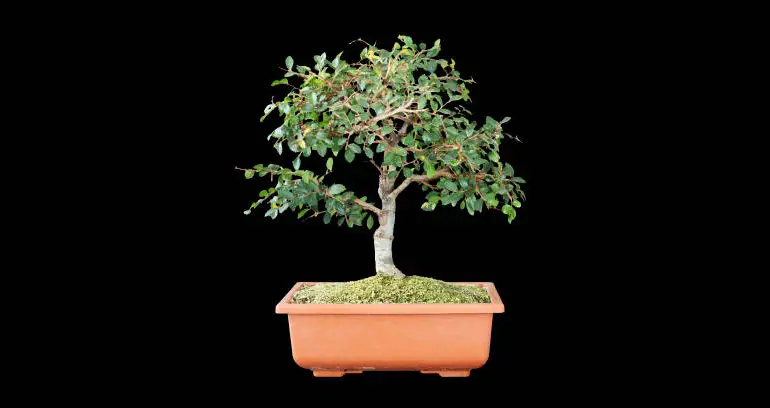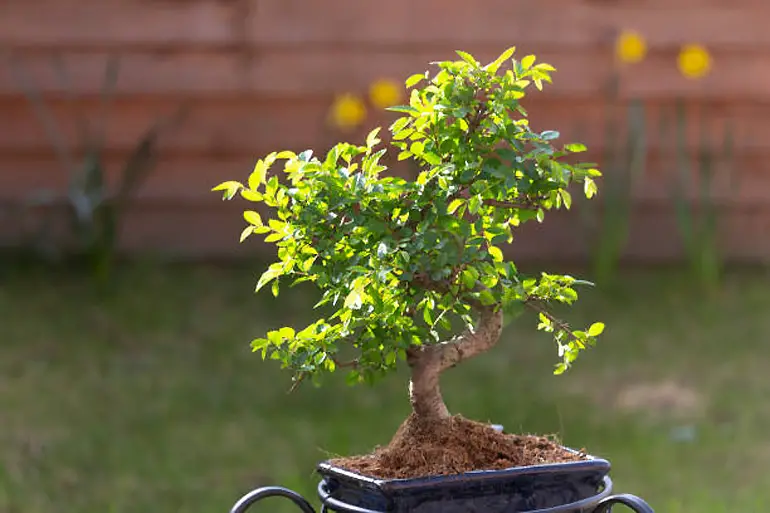Table of Contents
The Chinese Elm Bonsai is a lovely miniature tree with small serrated leaves of bright to deep green colour. This fantastic tree boasts a unique twig structure with excellent character throughout that makes this the ideal representation of a woodland tree.

After some time, its silvery bark will gently peel and reveal tan and red shades, which is also called the lacebark elm. This perfectly proportioned bonsai tree is superb, adaptable, and easy to care for.
| Scientific name | Ulmus Parvifolia |
| Average height | 40 to 50 feet |
| Average spread | 25 to 40 feet |
| Origin country | China, Korea, Japan |
| Family | Ulmaceae |
| Flower Bloom Time | August to September |
| Flower Bloom Color | Reddish-green |
| Water | Moderate |
| Sunlight | Full sun |
| Maintenance | Medium |
Chinese elm bonsai history
Chinese Elm is a tree indigenous to Southeast Asia and China. This can grow into a mighty tree in its native environment with a height of 80 feet and a trunk diameter of up to 3 feet. This produces a fine branch ramification that has small leaves, making it an ideal Bonsai plant.
The Chinese Elm has been used for Bonsai for many years and is a great choice for those who are just getting started because it is tolerant and slow-growing. It gives beginners lots of forgiveness and time to get used to bonsai care that make it among the most undemanding and most loved miniature trees.
How big are chinese elm bonsai
The Chinese Elm Bonsai can grow to a height of 8 to 10 inches with a width of 2 inches.
Chinese elm bonsai care

The Chinese Elm Bonsai has a distinctive and beautiful reddish-brown to dark gray bark that turns corky and fissure once mature. This has a pretty branching shape with oval-shaped toothed and delicate leaves with fresh green color and delightfully small leaf.
Its growth pattern is highly predictable that makes it perfect for beginners who are only starting to train Bonsai. Below are a few tips on how to care for a Chinese Elm Bonsai.
Chinese elm bonsai climate

While tolerant in general, the Chinese Elm Bonsai doesn’t like drafts or lots of temperature variations. Most indoor trees prefer temperatures ranging from 60 to 70 degrees Fahrenheit.
You can also keep Chinese Elm trees outdoors during summer. But, don’t forget to bring them indoors once the temperature goes lower than 60 degrees Fahrenheit. You can grow them in full sun and partial shade as well. If you are living in a mild climate, the tree can stay outside all year round.
Chinese elm bonsai fertilizer
Solid organic or liquid chemical fertilizer can be fed to your Chinese Elm Bonsai throughout the growing season.
Avoid feeding it when it is dormant during winter. There is no need to use a lot of fertilizer and there is also no need to use special types of fertilizers.
Chinese elm bonsai pruning
It is a wise idea to regularly prune your Chinese Elm Bonsai. This can thicken quickly if you leave it to its own devices. This means that you might need to trim your tree often as this can help in producing fresh buds.
Allow the shoots to extend out to up to 3 or 4 nodes before pruning this back to only one leaf or two. Late fall is the perfect time for pruning your Chinese Elm Bonsai.
Chinese elm bonsai repotting
The Chinese Elm Bonsai needs repotting every other year. Very old or large elms require less frequent repotting.
The ideal time for repotting your Chinese Elm Bonsai is in spring. The roots should be pruned with care, a task that calls for lots of concentration on your part.
Chinese Elm has intertwined and crooked roots that must be separated as much as possible. No special requirements for soil are necessary but it must be well-draining. Any standard soil mixture will be able to do the job.
Chinese elm bonsai pests and diseases
The Chinese Elm Bonsai is not that susceptible to most pests and diseases. Spider mites and scale are the only ones that you might have to deal with. Most of the time, a lack of humidity can further worsen these problems.
Pesticides can be used for removing spider mites. You can keep the pests at bay if you regularly mist your plant.
Chinese elm bonsai soil
As mentioned earlier, the Chinese Elm Bonsai doesn’t need any special requirements for soil and the only thing you need is well-draining. A typical soil mixture can be used for getting the job done.
Growing chinese elm bonsai

Even though you can grow the Chinese Elm Bonsai from seed, cuttings are more often used to propagate and grow it. Even beginners can do this easily with very minimal issues.
Watering chinese elm bonsai
You can liberally water the Chinese Elm Bonsai and you can do this as soon as the oil has started drying out. It is a must that you avoid long periods of dry spells although you also need to prevent prolonged wetness as this can lead to some problems with the tree’s roots.
Trimming chinese elm bonsai
The Chinese Elm Bonsai can thicken rather fast and needs frequent trimming for it to have a dense network made up of fine branches. Let the shoot extend for 3 to 4 nodes before you prune this back again to only 1 to 2 leaves.
The Chinese Elm Bonsai tree can bud well from the old wood even after it is pruned strongly. The perfect time for pruning bigger branches is during late fall. The Chinese Elm Bonsai is perfect for shaping with the usual guy wire and wiring techniques.
Is chinese elm bonsai good for indoor

The Chinese Elm Bonsai is among the most common species that are sold as Bonsais great for indoors although they also thrive well outdoors.
But, if you do choose to grow them indoors, the Chinese Elm Bonsai prefers to be kept inside a cool room and if possible, on a window sill in which it will get plenty of light.
Since the Chinese Elm is naturally deciduous, which means that these trees shed leaves during fall or winter, it is also common for leaves to become yellowish and shed once brought to another location. They should grow again when given the correct conditions.
What kind of indoor grow light to buy for chinese elm bonsai
Full-spectrum fluorescent bulbs are the best choice of indoor grow lights for your Chinese Elm Bonsai. These bulbs output the natural ultraviolet range contained in sunlight. Most of the grow lights for the other species might be based on incandescent bulbs yet these might quickly damage your Bonsai once used incorrectly.
Why chinese elm bonsai tree losing leaves

If your Chinese Elm Bonsai tree shows some signs of yellowing or it starts to lose leaves, normally the older ones instead of the new tips, there is often no need to worry.
While not all Bonsai trees show these symptoms, it is actually common, especially if it is just getting used to a new environment. Some leaves might drop but new bright green buds will start to develop in a matter of weeks.
How much humidity does a chinese elm bonsai tree need
As stated earlier, the Chinese Elm Bonsai is mainly an indoor tree as compared to others that tend to fare better when placed outside. This means that you should put your Chinese Elm Bonsai tree in a place where it will get plenty of sunlight but not necessarily under direct sunlight.
You also need to place it in a humid spot since heat may dry out your bonsai tree. During the months of summer, there is nothing wrong with putting your Chinese Elm Bonsai outside your house to let it absorb the highest amount of sunlight.
When is a safe time to repot a chinese elm bonsai
Like other types of bonsai trees, you need to repot your Chinese Elm Bonsai every year. The best time for repotting this kind of Bonsai tree is during the early months of spring before the new buds of the tree open up.
How to tell how old your chinese elm bonsai tree is
Unlike a normal tree, it is not possible to cut down your Bonsai tree to determine its age with the use of the number of rings it has.
The best method to know how old your Chinese Elm Bonsai is with the use of the simple equation of multiplying the diameter by growth factor to get a rough estimate of the tree’s age.
How to winterize bonsai chinese elm tree
During winter, your Chinese Elm Bonsai tree should be placed in the brightest spot possible while staying away from hot objects such as TVs and radiators. Good daylight is necessary for the overall health of your tree.
The Chinese Elm tends to thrive either in partial shade or full sun. You can leave this outdoors even during the months of winter if you are living in temperate climates. You can also bring your indoor Chinese Elm Bonsai outside during summer but it would be better to let it stay in a frost-free and cool room when winter comes.
These trees often endure some frost yet this will differ based on the region where it came from. The trees coming from the northern regions of China are the frost-hardiest ones compared to those that come from the southern regions.
Depending on the temperatures during winter, Chinese Elms can drop or keep their leaves until the spring season when new shoots show up.
Most common chinese elm tree problems
Despite being drought-resistant, Chinese Elm trees still face other issues. Edema and drowning are two of their common water-based problems. These trees are also prone to Dutch Elm disease, wood rot diseases, and anthracnose.
![Pittosporum Bonsai [Pittosporum Tobira]](https://www.bonsai-express.com/wp-content/uploads/2022/05/Pittosporum-Bonsai-365x200.jpg)
![Sorbus Bonsai [Sorbus Aucuparia]](https://www.bonsai-express.com/wp-content/uploads/2022/05/Sorbus-Bonsai-365x200.jpg)
![Tsuga Bonsai [Tsuga Canadensis]](https://www.bonsai-express.com/wp-content/uploads/2022/05/Tsuga-Bonsai-365x200.jpg)
![Tamarix Bonsai [Tamarix Ramosissima]](https://www.bonsai-express.com/wp-content/uploads/2022/05/Tamarix-Bonsai-365x200.jpg)